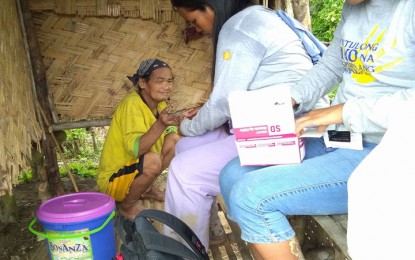
INTENSIFYING ANTI-MALARIA DRIVE. A volunteer microscopist and a barangay health worker are seen in this photo while doing blood smearing for malaria parasite on a Pala'wan indigenous people in the mountains of Rizal municipality in southern Palawan. (Photo courtesy of KLM)
PUERTO PRINCESA CITY, Palawan -- Palawan's sustainable malaria control program, Kilusan Ligtas Malaria (KLM), has moved its target of making the province free from the mosquito-borne tropical disease to 2030.
KLM program manager Aileen Balderian said Thursday the original target was in 2020 but the change was made to align it with the national government’s aim of a malaria-free Philippines.
“Nabago na siya. Ngayon ang buong Pilipinas kasama ang Palawan ay nag-a-aim ng by 2030, whole Philippines ang malaria-free. Bago makarating ang 2030 dapat by 2025 nasa elimination phase na ang Palawan para ma-declare ang buong Pilipinas na free sa malaria (It has been changed. The Philippines now, including Palawan, are aiming that by 2030 it’s already malaria-free. Before we reach 2030, we should already be in the elimination phase by 2025 to declare the whole Philippines malaria-free),” she said.
Balderian added that currently, the province is in the “control phase” since malaria positive cases logging remains to be almost 1,000.
In the elimination phase, she said the province should no longer be able to diagnose positive cases even if the KLM is continuing its blood smearing for malaria parasite (BSMP) activities.
“Ibig sabihin dapat wala na tayong mada-diagnose na positive malaria cases kahit tuluy-tuloy pa ang ating pag-smear (It means there should no longer be positive malaria cases that we can detect even if our smearing activities are continuing),” she said.
Balderian said the KLM has since intensified its strategies to fight malaria by now going to upland communities, where the indigenous peoples (IPs) live, to look for cases since they are prone to the mosquito-borne disease.
Involved in this strategy implementation are 242 barangay microscopists and 244 rapid diagnostic testing (RDT) personnel, who directly go to uncharted areas to provide 15-minute BSMP to suspected malaria-affected residents.
“Hindi gaya dati, ngayon kailangan nilang umakyat sa mga kabundukan para doon maghanap ng mga cases. Hanapin isa-isa o magbabahay-bahay para mag-focus sa cases identification (Unlike before, they now have to go up to the mountains to look for cases. Look for them one-by-one or go house-to-house to focus on cases identification),” Balderian expressed.
In their past monitoring, the KLM targeted 432 barangays in Palawan, but this number went down when many municipalities were declared malaria-free.
These are the towns of Culion, Coron, Busuanga, Dumaran, Agutaya, Kalayaan in the West Philippines Sea, which had not registered positive malaria cases during the past three years.
Balderian added that case detection is now focused in southern Palawan, particularly in Rizal, Balabac, Bataraza, Quezon, and Brooke’s Point -- the top five municipalities with the highest number of malaria incidents.
“Rizal remains to be the number one town where many malaria cases had been detected in the past followed by Balabac, Bataraza, Quezon, and Brooke’s Point. But if you will assess it, the situation in these areas has improved over the years against malaria,” she said.
Barangay Ransang in Rizal, where the Tau’t Bato IP community in Singnapan Valley can be found, remains to be under closed monitoring, especially that the tribe's members are not known to seek medical help due to their distance to the barangay health centers.
She said the situation in this IP community has improved as there are volunteers now who regularly go to them to do BSMP.
The KLM found out three weeks ago, she said, that the IPs are prone to contract the mosquito-borne disease because their high ground homes have no walls. Their sleep patterns are also unpredictable, so even the distribution of treated bed nets is useless.
She said what the KLM is doing is to stress the importance of prevention in the indigenous communities.
In 2017, she said Palawan recorded an estimated 3,808 positive malaria cases. The whole Philippines has over 4,002 cases, and the province contributed more than 92 percent.
But she said this figure is already a far cry from the 2016 recorded cases of over 7,000 with six deaths, and much more the over 100,000 positive patients detected in 1999.
“This year, nasa half year na tayo, between January and June, meron na tayong nasa almost 1,800 cases. (This year, we’re already halfway in the year, between January and June, we’ve already recorded almost 1,800 cases),” she said.
Balderian said malaria deaths can be avoided if residents will make the “kabit kulambo” (regular treated bed net use) a lifestyle in areas where mosquito carriers abound.
She also advised completing the medication if a person is detected to be positive of malaria.
The KLM is supported by the provincial government of Palawan in close partnership with the Pilipinas Shell Foundation, Inc. and the non-profit Global Fund to Fight AIDS, Tuberculosis, and Malaria. (PNA)
